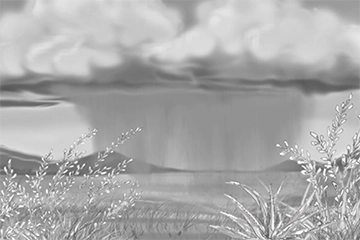

It is dry! The sun beats down from a sky of brilliant blue. The native trees and bushes droop pitifully as they try to stay alive by dropping most of their leaves. The cattle ponds are parched, cracked dirt, and the creek hasn’t run in so long there are small bushes and weeds growing in its bed. It’s June in Arizona’s drought-ravaged high desert. My skin becomes a desicated sponge looking for even a small drop of moisture to soak up. The garden struggles to survive.
But then July rolls around. In July, I anxiously scan the afternoon skies for those tall clouds with cookie cutter tops and the dark, layered bottoms. Any morning can create air that becomes increasingly more humid and sultry. Breathing underwater becomes an apt description. When afternoon clouds do appear at the horizon and then swiftly build, a sudden breeze will soothe my body, and the rain isn’t far behind. I tend to stay out in it and soak up the wet until a huge clap of thunder sends me racing for shelter. Sometimes, of course, the rain misses my canyon and garden, but if it falls close enough there is the sudden 20o drop in temperature, and the heat of the day is broken anyway. Those who have never lived through the heat of June in the desert can hardly imagine the sensation of the first rain of summer and the look of plants who are simply a prayer in motion as they perk up and drink every drop that falls.
—By Pat Romero of Globe, AZ.



